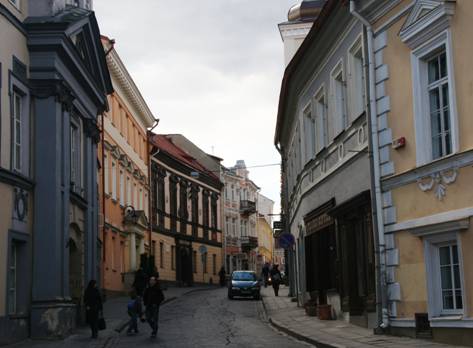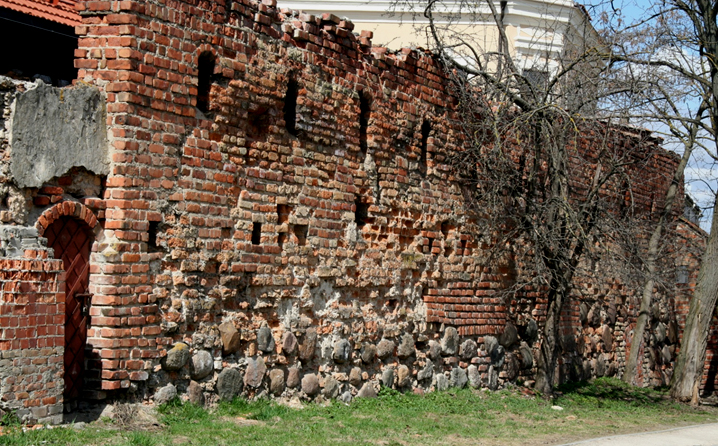
THE VOICE OF INTERNATIONAL LITHUANIA
|
VilNews has its own Google archive! Type a word in the above search box to find any article.
You can also follow us on Facebook. We have two different pages. Click to open and join.
|
Vilnius Old Town is
unique in the world

Dominikonu Street in Vilnius Old Town. The colours play together. The
attention to detail is great.
Photo: Aage Myhre.
Text: Aage Myhre, architect and editor.
From an architectural point of view, the Vilnius Old Town is unique. In the world. It can also be justified to call this the world's most international city, taking into account all nations and cultures that have been involved in its planning and construction over many centuries.
It was here architects and builders from Italy and other Mediterranean countries came to shape the international Vilnius almost 700 years ago, along with experts from Central Europe. The influence of the city's large Jewish community was also very evident throughout the centuries.
It is to Vilnius you should come if you want to watch an entire people's ancient spirit, expressed in a beautiful, special setting unmatched anywhere else. It is when you walk around in the streets here that you will understand why Vilnius has been named as the 'New Babylon', 'Jerusalem of the North', 'The world's most Italian city outside Italy' and 'The world's most baroque city north of the Alps'.
It's when you feel the round cobbles in the streets pushing up against your shoe soles that you can fully understand the concepts of multiculturalism and multi-nationalism, as you could find it in Old Vilnius.
Architecture is a reflection of the level of development and maturity of any nation in the world. The architecture of Vilnius
Old Town tells us about the outstanding wisdom and multiculturalism that hallmarked this country for hundreds of years.
Vilnius architecture reflects European styles - Gothic, Renaissance, Baroque, Classicism, and more - because Lithuania's ancient leaders knew how to seek advice and expert assistance from outside. Simultaneously the city developed its own unique style.
Vilnius was, during the centuries following 1323, the year the city was founded, fully on a par with cities further west and south in Europe.
In the 1500s, Vilnius was one of Europe's three leading renaissance cities, on par with Florence and Milan.
But the styles represent only one side of it. Equally important was the fact that the contemporary leaders,
urban planners and architects followed holistic planning ideals.
The areas between the buildings were as important as the buildings themselves. Human dimensions and scale was the excellent ideal. That’s how the planners of those days paved the way for good, interactive human life and activity in Vilnius.
Therefore, also today, the old Vilnius is a good, lively and warm city to live in for people from many nations and cultures.
Capitals around the world have their special features and icons, often very important symbols of the countries they represent. Paris has the Eiffel Tower. London has its bridge. Rome has the Colosseum. Washington has the White House, Berlin has its Brandenburg Gate.
Vilnius has its wonderful Old Town that was once among the world's foremost symbols of tolerance and
peaceful coexistence and from many different nationalities and cultures. A city that exuded peace, harmony and 'good life'. A city that went ahead in humanity.
Things have changed, but the Old Town of Vilnius remains the same.

Vilnius Old Town is genuine! Here a fragment of the old city wall from the 1500s.
Photo: Aage Myhre.
- Bookmark :
- Digg
- del.icio.us
- Stumbleupon
- Redit it
VilNews e-magazine is published in Vilnius, Lithuania. Editor-in-Chief: Mr. Aage Myhre. Inquires to the editors: editor@VilNews.com.
Code of Ethics: See Section 2 – about VilNews. VilNews is not responsible for content on external links/web pages.
HOW TO ADVERTISE IN VILNEWS.
All content is copyrighted © 2011. UAB ‘VilNews’.

 Click on the buttons to open and read each of VilNews' 18 sub-sections
Click on the buttons to open and read each of VilNews' 18 sub-sections 



[…] Read more… Category : Front page […]